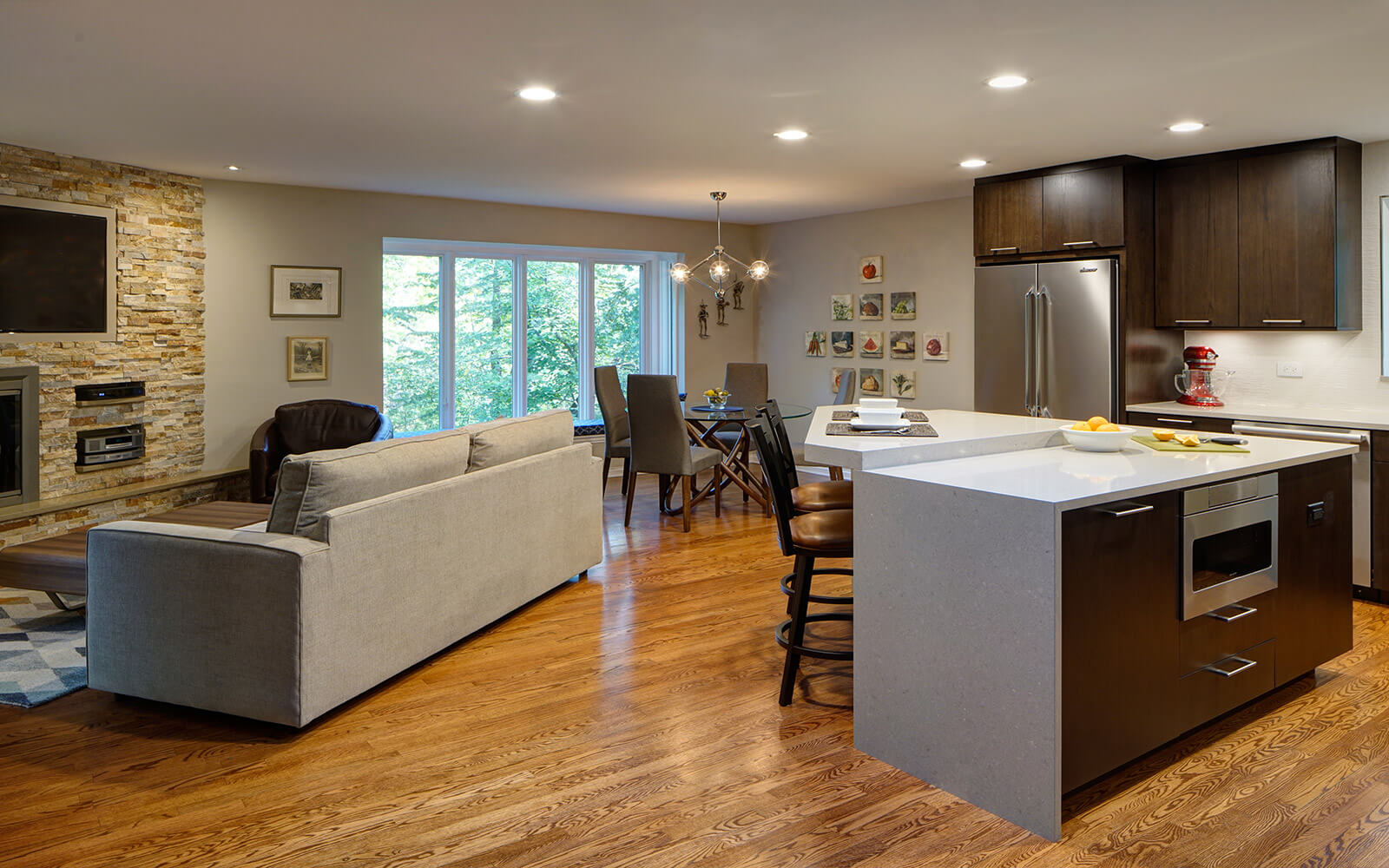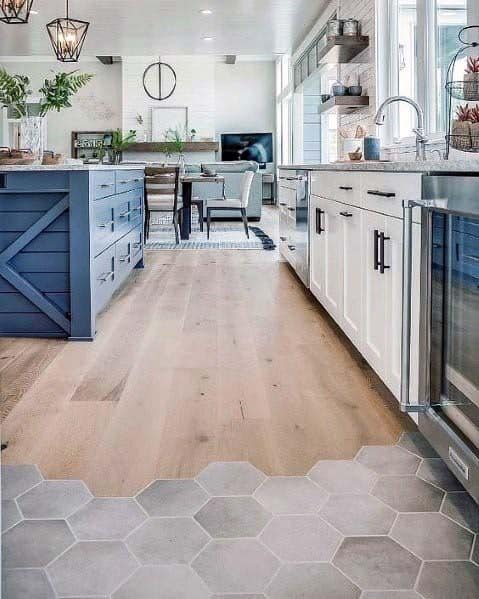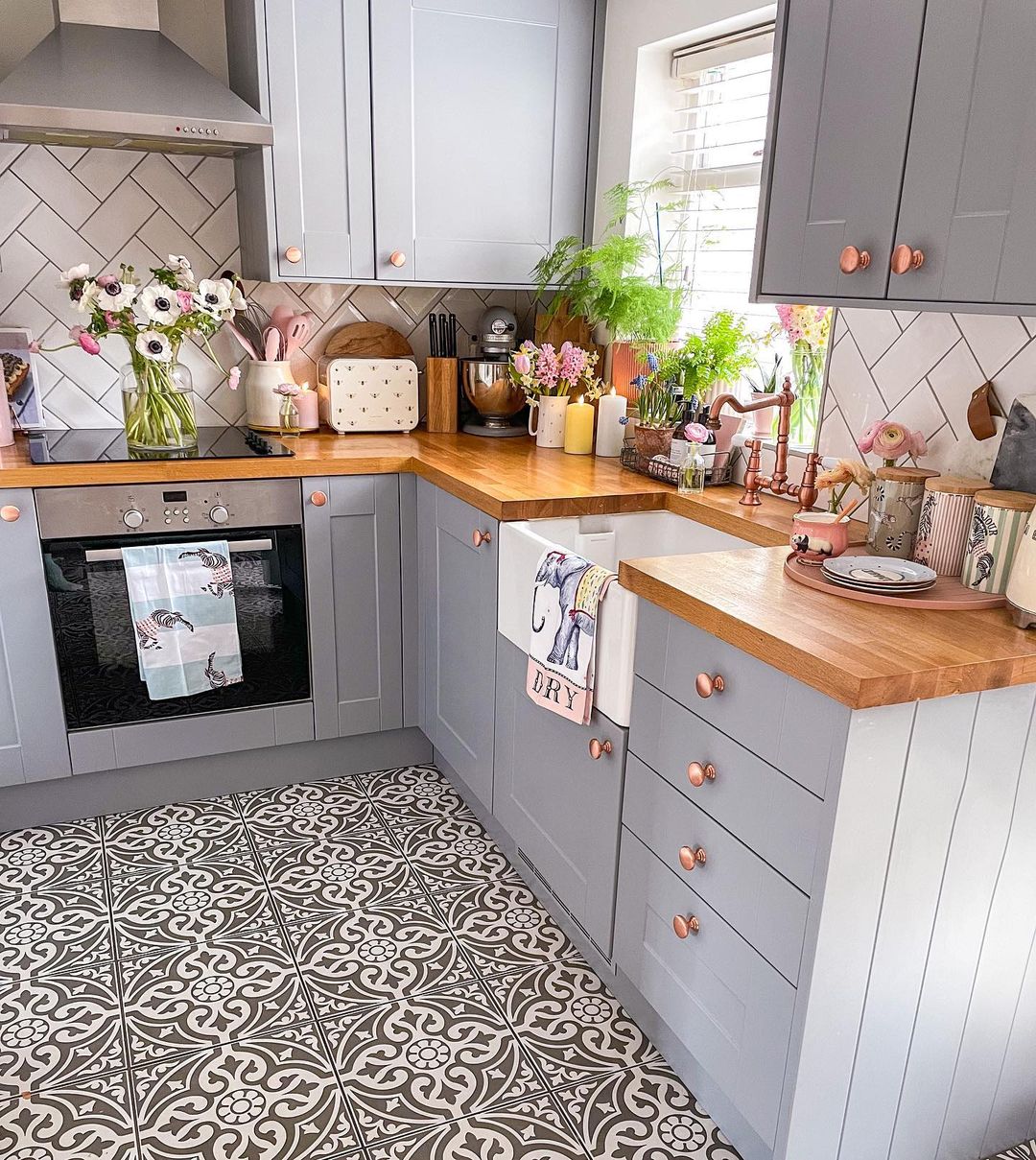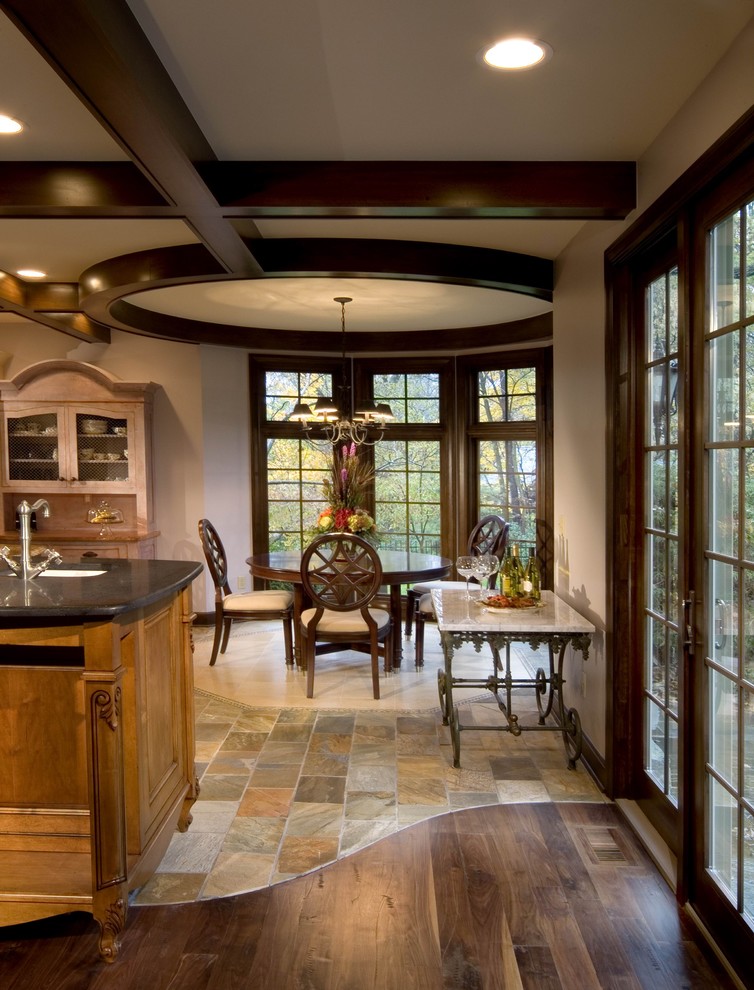Kitchen & Living Room Flooring: The Perfect Blend
Kitchen & Living Room Flooring: The Perfect Blend
The heart of your home, where laughter echoes, meals are shared, and memories are made, is often a combination of the kitchen and living room. These spaces, often open to one another, demand a flooring solution that seamlessly blends practicality and aesthetics. Choosing the right flooring can be a daunting task, but it doesn't have to be.
This guide dives deep into the world of kitchen and living room flooring, exploring various materials, their pros and cons, and how to achieve the perfect blend for your unique style and lifestyle.
Factors to Consider:
Before embarking on your flooring journey, it's essential to consider these key factors:
1. Lifestyle:
- Foot traffic: How much foot traffic does the space receive? High-traffic areas require durable materials.
- Pets: Do you have pets? Consider materials that resist scratches and stains.
- Kids: Are children frequently present? Durability and easy cleaning are paramount.
2. Aesthetics:
- Style: What is your overall design aesthetic? Modern, traditional, rustic, contemporary?
- Color scheme: Choose a floor color that complements your existing furniture and decor.
- Lighting: How much natural and artificial light does the space receive? Lighter colors reflect light, while darker shades create a cozy ambiance.
3. Budget:
- Material cost: Flooring options vary significantly in price.
- Installation costs: Factor in the cost of professional installation or DIY labor.
- Maintenance: Some materials require more upkeep than others.
4. Practical Considerations:
- Water resistance: Is the space prone to spills? Choose waterproof or water-resistant materials.
- Sound insulation: Do you need to minimize noise between the kitchen and living room?
- Comfort: Consider the feel of the flooring underfoot. Some materials offer a softer, more comfortable experience.
Flooring Options for a Combined Kitchen & Living Room:
1. Hardwood Flooring:

- Pros: Timeless elegance, durable, easy to clean, adds value to your home.
- Cons: Can be expensive, susceptible to scratches and water damage, not always suitable for high-traffic areas.
- Best for: Traditional, modern, and farmhouse styles.
2. Engineered Hardwood Flooring:
- Pros: More affordable than solid hardwood, stable and less prone to warping, offers various finishes and colors.
- Cons: Not as durable as solid hardwood, limited number of refinishing options.
- Best for: Modern, contemporary, and eclectic styles.

3. Tile Flooring:
- Pros: Durable, water-resistant, versatile in design, easy to clean.
- Cons: Can be cold underfoot, can be slippery, can be noisy, may require grout maintenance.
- Best for: Traditional, modern, and contemporary styles.
4. Porcelain Tile:

- Pros: Durable, scratch-resistant, stain-resistant, water-resistant, available in a wide range of styles and colors.
- Cons: Can be expensive, cold underfoot, may require grout maintenance.
- Best for: Modern, contemporary, and industrial styles.
5. Laminate Flooring:
- Pros: Affordable, durable, water-resistant, easy to install, available in various styles and colors.
- Cons: Can be less durable than hardwood or tile, can feel artificial, limited number of refinishing options.
- Best for: Modern, contemporary, and budget-friendly styles.

6. Vinyl Plank Flooring:
- Pros: Durable, water-resistant, comfortable underfoot, easy to install, available in a wide range of styles and colors, affordable.
- Cons: Can be less durable than hardwood or tile, may not offer the same level of aesthetics as some other options.
- Best for: Modern, contemporary, and traditional styles.
7. Cork Flooring:

- Pros: Sustainable, soft underfoot, naturally water-resistant, good sound insulation.
- Cons: Can be more expensive than some other options, prone to dents and scratches, may require sealant.
- Best for: Eco-friendly, minimalist, and modern styles.
8. Concrete Flooring:
- Pros: Durable, easy to maintain, can be polished to a high shine, versatile in style.
- Cons: Can be cold underfoot, may require specialized cleaning and sealing.
- Best for: Industrial, modern, and minimalist styles.

Considerations for a Seamless Blend:
1. Color and Pattern Consistency:
- Choose flooring that complements the existing color palette and style of both the kitchen and living room.
- Consider pattern continuity. For example, a wood plank flooring pattern can run seamlessly from one room to the other.
- Use rugs strategically to define spaces and introduce additional color and texture.

2. Transitioning Between Materials:
- If you're using different flooring materials in the kitchen and living room, ensure a smooth transition.
- Use transitions strips or molding to create a clean line and prevent tripping hazards.
- Consider using different sizes of the same tile or plank to create a visual transition.
3. Lighting and Texture:

- Lighting plays a crucial role in how flooring appears. Consider the natural light and artificial lighting in both rooms.
- Texture can create visual interest and contrast. Combine smooth and textured flooring for a dynamic look.
4. Functional Zones:
- Define different zones within the space using flooring. For example, a more durable tile in the kitchen work area and softer wood flooring in the living room.
- Color variations within the same flooring material can also delineate areas without appearing abrupt.
Tips for Choosing the Perfect Flooring:
- Sample: Order samples of your chosen flooring materials to see them in your space under different lighting conditions.
- Professional Consultation: Consult with a flooring specialist to discuss your options and get expert advice.
- Read Reviews: Research and read reviews of different flooring brands and products to gain insights from real users.
- Consider the Future: Think about the longevity and maintenance requirements of your chosen flooring.
- Don't Rush: Take your time to make an informed decision that fits your budget, style, and lifestyle.
Conclusion:

Choosing the right flooring for a combined kitchen and living room involves careful consideration of your personal style, lifestyle, and budget. By understanding the pros and cons of each material and incorporating design elements that promote harmony, you can create a space that is both functional and aesthetically pleasing. From the durable charm of hardwood to the modern elegance of tile, the possibilities are endless. So, embark on your flooring journey with confidence, knowing you have the knowledge to create a space that reflects your unique vision and makes your home a true sanctuary.
Kitchen & Living Room Flooring: Where Style Meets Function
The heart of any home, the kitchen and living room, are spaces that demand careful consideration, especially when it comes to flooring. These rooms are high-traffic areas, subject to spills, foot traffic, and the inevitable wear and tear of everyday life. But beyond functionality, they also serve as gathering places, reflecting your personal style and creating the ambiance you desire. Finding the perfect flooring solution for these spaces means striking a balance between practicality and aesthetics – a delicate dance where style meets function.
This comprehensive guide will explore the best flooring options for your kitchen and living room, taking into account both their unique demands and your personal design preferences. We’ll delve into the pros and cons of each type, offering insightful tips to help you make informed decisions and create a space that's both beautiful and durable.
Considerations for Kitchen and Living Room Flooring
Before diving into specific flooring types, let's establish the key factors that should guide your decision-making process:
1. Traffic:
Your kitchen and living room are likely the busiest areas in your home. High traffic can lead to wear and tear, so consider flooring materials that are durable and scratch-resistant.
2. Moisture Resistance:
The kitchen, in particular, is prone to spills and splashes. Choose water-resistant or waterproof flooring to avoid water damage and ensure longevity.
3. Aesthetics:
Your flooring choice should complement the overall design aesthetic of your kitchen and living room. Consider the existing color scheme, furniture, and style when making your decision.
4. Maintenance:
Some flooring options require more maintenance than others. Think about how much time and effort you're willing to invest in cleaning and upkeep before making a final choice.
5. Budget:
Flooring prices can vary considerably. Set a realistic budget and explore options that fit within your financial constraints.
Flooring Options for Your Kitchen and Living Room: A Detailed Breakdown
Now let's dive into the most popular flooring options, analyzing their strengths and weaknesses:
1. Hardwood Flooring:
Pros: * Timeless Elegance: Hardwood flooring exudes sophistication and adds warmth to any space. * Durability: When properly maintained, hardwood floors can last for decades. * Natural Beauty: With a wide range of wood species, colors, and finishes, you can find a hardwood floor that perfectly complements your aesthetic preferences. * Value Appreciation: Hardwood flooring is a wise investment, adding value to your home.
Cons: * Cost: Hardwood flooring is one of the more expensive flooring options. * Maintenance: Hardwood floors require regular cleaning, polishing, and refinishing to maintain their beauty. * Scratch Susceptibility: While durable, hardwood floors can be scratched by sharp objects. * Moisture Sensitivity: Hardwood flooring is susceptible to water damage, making it less suitable for kitchens prone to spills.
2. Engineered Hardwood Flooring:
Pros: * Improved Stability: Engineered hardwood flooring is less prone to warping and shrinking due to humidity changes, making it a better option for kitchens and bathrooms. * Cost-Effective: Engineered hardwood is typically less expensive than traditional hardwood flooring. * Variety of Styles: Like traditional hardwood, engineered hardwood offers a wide array of wood species, colors, and finishes.
Cons: * Durability: Engineered hardwood floors are generally less durable than solid hardwood. * Limited Refinishing: Engineered hardwood can only be refinished a few times before the top layer wears down. * Less Sustainable: Engineered hardwood often uses less sustainable materials than solid hardwood.
3. Laminate Flooring:
Pros: * Affordability: Laminate flooring is a budget-friendly option, offering a wide range of styles and colors. * Durability: Laminate flooring is scratch-resistant, stain-resistant, and water-resistant, making it a practical choice for high-traffic areas. * Ease of Maintenance: Laminate flooring requires minimal maintenance, making it an excellent option for busy families. * Wide Selection: Laminate flooring mimics the look of various materials, including wood, stone, and tile.
Cons: * Synthetic Appearance: Laminate flooring is not as natural or elegant as hardwood. * Limited Refinishing: Laminate flooring cannot be refinished like hardwood or engineered hardwood. * Potential for Cracking: Laminate flooring can crack or chip if dropped objects.
4. Vinyl Flooring:
Pros: * Water-Resistant: Vinyl flooring is completely waterproof, making it an ideal choice for kitchens, bathrooms, and other wet areas. * Durability: Vinyl flooring is highly durable and scratch-resistant. * Easy to Clean: Vinyl flooring is easy to clean and maintain. * Affordable: Vinyl flooring is a cost-effective flooring option. * Wide Range of Styles: Vinyl flooring is available in a wide array of colors, patterns, and textures.
Cons: * Synthetic Material: Vinyl flooring is a synthetic material, which may not appeal to those seeking natural materials. * Potential for Fading: Vinyl flooring can fade over time if exposed to direct sunlight. * Less Comfortable: Vinyl flooring can feel hard and cold underfoot.
5. Luxury Vinyl Tile (LVP) and Luxury Vinyl Plank (LVP):

Pros: * High-End Appearance: LVP and LVP offer the look of natural materials like wood and stone but with increased durability and water resistance. * Wide Variety: LVP and LVP come in a variety of styles, colors, and textures, allowing for a high level of customization. * Durable: LVP and LVP are highly durable, scratch-resistant, and dent-resistant. * Water-Resistant: LVP and LVP are water-resistant, making them suitable for kitchens, bathrooms, and other wet areas.
Cons: * Cost: LVP and LVP are more expensive than traditional vinyl flooring. * Potential for Cracking: LVP and LVP can crack or chip if dropped objects.
6. Tile Flooring:

Pros: * Durability: Tile flooring is known for its durability and longevity. * Water Resistance: Tile flooring is completely waterproof, making it an excellent option for kitchens and bathrooms. * Easy to Clean: Tile flooring is easy to clean and maintain. * Wide Variety: Tile flooring is available in a vast array of materials, colors, patterns, and sizes, offering endless possibilities for design.
Cons: * Cold and Hard: Tile flooring can feel cold and hard underfoot. * Slippery: Tile flooring can be slippery when wet. * Grout Maintenance: Grout lines between tiles require regular cleaning and sealing. * Cost: Tile flooring can be expensive, especially for higher-quality materials.
7. Stone Flooring:

Pros: * Natural Beauty: Stone flooring offers a unique and timeless elegance. * Durability: Stone flooring is incredibly durable and long-lasting. * Water Resistance: Stone flooring is water-resistant, making it suitable for kitchens and bathrooms.
Cons: * High Cost: Stone flooring is one of the most expensive flooring options. * Cold and Hard: Stone flooring can feel cold and hard underfoot. * Maintenance: Stone flooring requires regular cleaning and sealing to maintain its beauty and protect it from stains.
8. Concrete Flooring:

Pros: * Durability: Concrete flooring is incredibly durable and long-lasting. * Versatility: Concrete flooring can be stained, polished, or painted to achieve a wide range of looks. * Eco-Friendly: Concrete is a sustainable material.
Cons: * Cold and Hard: Concrete flooring can feel cold and hard underfoot. * Maintenance: Concrete flooring requires regular cleaning and sealing. * Potential for Cracking: Concrete flooring can crack if not properly installed or maintained.
Factors to Consider for Choosing Flooring for Your Kitchen and Living Room

With a plethora of flooring options available, choosing the right one for your kitchen and living room requires careful consideration.
1. Your Personal Style and Preferences:
- Do you prefer the warmth and elegance of hardwood or the sleek and contemporary look of tile?
- Are you drawn to the natural beauty of stone or the modern appeal of luxury vinyl plank?
- What type of color palette and texture do you envision for your space?

2. Budget:
- Setting a realistic budget will help narrow down your options.
- Hardwood, stone, and LVP are typically the most expensive choices, while laminate and vinyl are more affordable.
3. Lifestyle and Traffic:

- If your kitchen and living room experience high traffic, consider durable options like hardwood, tile, or LVP.
- If you have pets or young children, you might want to choose a scratch-resistant flooring like laminate, tile, or LVP.
4. Maintenance:
- Think about how much time and effort you're willing to invest in cleaning and maintenance.
- Hardwood and tile require more maintenance than laminate or vinyl.

5. Environmental Concerns:
- If you're environmentally conscious, consider sustainable flooring options like bamboo, cork, or recycled materials.
Tips for Making the Right Choice:
- Visit Flooring Showrooms: See the flooring options in person to get a sense of their texture, color, and durability.
- Get Samples: Order samples of your favorite flooring options to see how they look in your kitchen and living room.
- Consult with a Flooring Professional: A flooring specialist can provide expert advice on choosing the right flooring for your needs and budget.
- Consider the Future: Think about how your flooring choices will affect the resale value of your home.
Conclusion:
Choosing the perfect flooring for your kitchen and living room is a crucial step in creating a space that's both beautiful and functional. By carefully considering the factors outlined above, you can select a flooring solution that will enhance your living experience for years to come.

Remember, the best flooring is one that meets your individual needs, reflects your personal style, and enhances the beauty and functionality of your home. .
